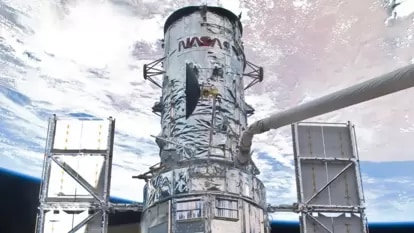Powerful Solar winds set to spark solar storm today and tomorrow, NASA reveals the danger
A new forecast predicts a solar storm on Earth between November 8 and 9, as a stream of high-velocity solar winds is moving towards our planet. The solar storm is coming from a large hole in the Sun, as shown by NASA SDO.


It appears that the solar storm trouble for Earth is not going to end anytime soon. After already sparking a G3-class and a G1-class storm within a week, there is a possibility that another solar storm might be triggered soon. But unlike the previous two incidents, this one will not be caused by coronal mass ejections (CMEs). Instead, fast-moving solar winds may be responsible for it. A similar storm shook the Earth on October 28, when a crack in the magnetic fields of Earth opened up. While that's not the case this time, the intense bombardment of solar winds is forecasted to bring a solar storm between today, November 8, and tomorrow, November 9.
According to a report by SpaceWeather, “Minor G1-class geomagnetic storms are possible on Nov. 8th and 9th when Earth enters a stream of fast-moving solar wind. The gaseous material is flowing from a southern hole in the sun's atmosphere”. It was also mentioned that auroras could be visible in the high latitude regions.
Solar storm expected tomorrow
The forecast anticipates a G1-class storm, indicating that it is likely to trigger auroras and potentially interfere with radio waves, leading to disruptions in communication for various groups such as mariners, aviators, drone pilots, and amateur radio operators.
Yet, solar storms have the potential for far-reaching consequences. In the most severe instances, these storms can disrupt GPS and mobile networks, impede internet connectivity, harm satellites, trigger power grid failures, and even compromise ground-based electronics.
The role of the NASA Solar Dynamics Observatory
The NASA Solar Dynamics Observatory (SDO) carries a full suite of instruments to observe the Sun and has been doing so since 2010. It uses three very crucial instruments to collect data from various solar activities. They include the Helioseismic and Magnetic Imager (HMI) which takes high-resolution measurements of the longitudinal and vector magnetic field over the entire visible solar disk, Extreme Ultraviolet Variability Experiment (EVE) which measures the Sun's extreme ultraviolet irradiance, and Atmospheric Imaging Assembly (AIA) which provides continuous full-disk observations of the solar chromosphere and corona in seven extreme ultraviolet (EUV) channels.
Catch all the Latest Tech News, Mobile News, Laptop News, Gaming news, Wearables News , How To News, also keep up with us on Whatsapp channel,Twitter, Facebook, Google News, and Instagram. For our latest videos, subscribe to our YouTube channel.
































